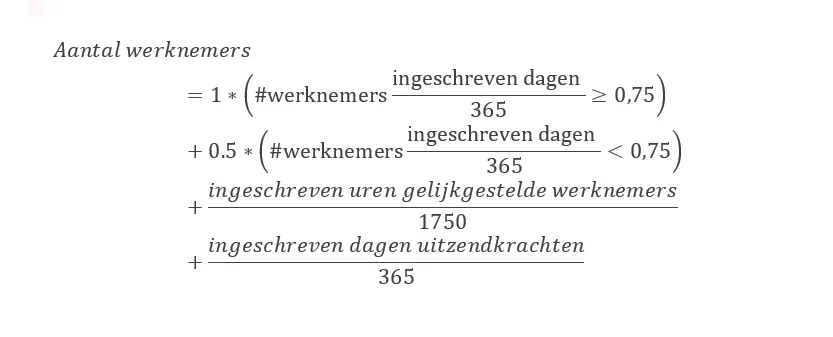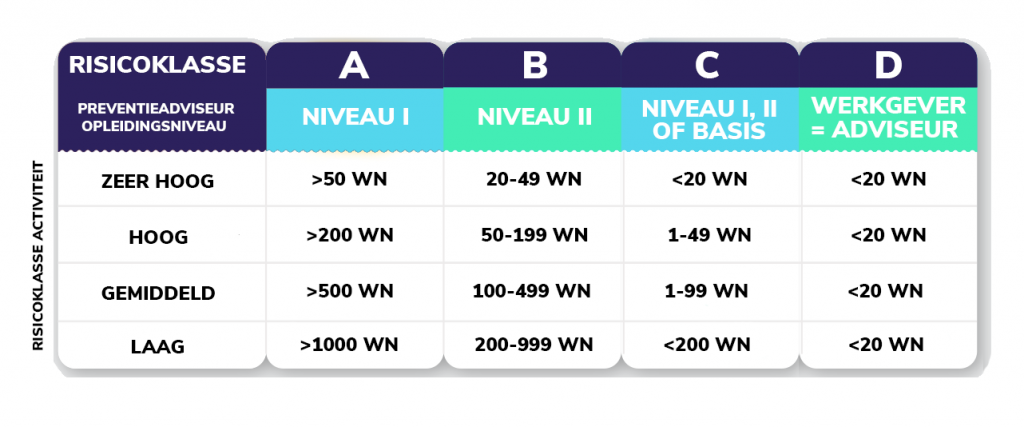Welke opleiding moet een preventieadviseur hebben?
En is een interne preventieadviseur in mijn bedrijf verplicht?

Inhoudsopgave
Wanneer is een interne preventieadviseur verplicht?
Elke werkgever heeft de wettelijke verplichting om actief deel te nemen aan preventieve maatregelen voor welzijn op het werk. Vanaf het moment dat een werkgever zijn eerste werknemer in dienst neemt, wordt verwacht dat er op alle gebieden van welzijn preventieve acties worden ondernomen.
In dit kader moet er altijd een preventieadviseur worden aangesteld. Hoewel er in beperkte gevallen ruimte is voor werkgevers om zelf als preventieadviseur op te treden, is dit niet langer het geval bij activiteiten met een hoog risico en in grotere ondernemingen.
Heb je nog geen preventieadviseur, zorg dan dat je iemand intern laat opleiden of stel een externe preventieadviseur aan.
Hoe verloopt de concrete berekening?
Artikel II.1-2.-§1 van de Codex classificeert alle ondernemingen in verschillende groepen (A, B, C of D) op basis van het aantal werknemers (WN) en de bedrijfsactiviteit (met name het risico). Deze twee factoren zijn cruciaal voor het vereiste opleidingsniveau van de preventieadviseur.
De tekst van de Welzijnswet, zoals veel wetsteksten, is niet altijd eenvoudig te begrijpen. Prevom streeft ernaar de voorwaarden en berekeningen zo begrijpelijk mogelijk te maken en hanteert daarvoor een driestappenproces:
- Stap 1: Risicobepaling
- Stap 2: Hoeveelheid WN berekenen
- Stap 3: Verplicht opleidingsniveau vaststellen
Het risiconiveau bepalen
Het bepalen van het risiconiveau is cruciaal, en zoals eerder genoemd, is het opleidingsniveau van de preventieadviseur direct gekoppeld aan het risico van de bedrijfsactiviteit. Het overzicht moet zorgvuldig worden doorlopen, waarbij de classificering van het bedrijf van groot belang is. Belangrijk om op te merken is dat de hoogste categorie altijd prioriteit heeft!
Bijvoorbeeld: een metaalverwerkend bedrijf valt onder het gemiddelde risico, terwijl een bedrijf dat producten produceert uit metaal onder hoog risico valt. Zelfs als jouw bedrijf technisch gezien ook een metaalverwerkend bedrijf is, valt het onder hoog risico als het producten uit metaal produceert.
Belangrijk om op te merken is dat de hoogste categorie altijd prioriteit heeft!
Hulp nodig bij het
aanstellen van een adviseur?
Zeer hoog risico
- Industrie voor winning en vervaardiging van splijt- en kweekstoffen
- Cokesovenbedrijven
- Aardolie-industrie
- Chemische grondstoffenfabrieken
- Petro- en carbochemische industrie
- Industrie voor de vervaardiging van andere chemische producten met voornamelijk industriële of agrarische toepassing
Hoog risico
- Industrie voor productie en distributie van elektriciteit, gas, stoom en warm water
- Industrie voor vervaardiging en eerste verwerking van metalen
- Industrie voor vervaardiging van steen, cement, betonwaren, aardewerk, glas en dergelijke
- Chemische industrie die niet behoort tot de ondernemingen eerder vermeld in de categorie zeer hoog risico (alles behalve chemische grondstoffenfabrieken, petro- en carbochemische industrie & productie van chemische producten voor industrie of agrarische toepassing)
- Kunstmatige en synthetische continugaren- en vezelindustrie
- Industrie voor vervaardiging van producten uit metaal
- Machinebouwnijverheid
- Industrie van de automobielbouw en fabrieken van auto-onderdelen
- Overige transportmiddelenfabrieken
- Houtindustrie en fabrieken van houten meubelen
- Bouwnijverheid
- Vleesverwerkende nijverheid
- Menselijke gezondheidszorg
- Vervoer en opslag
Hoog risico
- Industrie voor winning, reiniging en distributie van water
- Metaalverwerkende, fijnmechanische en optische industrie die niet behoort tot de ondernemingen eerder vermeld in de categorie hoog risico (alles behalve vervaardiging van producten uit metaal, machinebouwnijverheid, automobielbouw/auto-onderdelen en overige transportmiddelenfabrieken).
- Andere bewerkende en verwerkende industrieën die niet behoren tot de ondernemingen vermeld in de categorie hoog risico (alles behalve machinebouwnijverheid & vleesverwerkende nijverheid).
Laag risico
Alle bedrijven die niet vallen onder de hogere risicogroepen. Deze categorie omvat bedrijven waarvan de activiteit inherent minder risicovol is voor personeel, zoals groot- & detailhandel, een consultingkantoor, enz.
Berekening van het aantal werknemers
Naast het risico speelt ook het aantal werknemers een cruciale rol.
Dit vereist meer dan een eenmalige beoordeling: er wordt teruggekeken naar de afgelopen vier trimesters om vast te stellen hoeveel werknemers een bedrijf heeft in het kader van preventie.
De specifieke berekeningswijze voor het aantal werknemers van een onderneming is helder vastgelegd in Art. II.1-2.-§2 van de Codex.
De procedure wordt als volgt omschreven:
“Het aantal werknemers wordt berekend door het aantal kalenderdagen waarop elke werknemer, gedurende een periode van de vier trimesters die elk trimester voorafgaan, ingeschreven is in het personeelsregister waarvan het bijhouden wordt opgelegd door het koninklijk besluit nr. 5 van 23 oktober 1978 betreffende het bijhouden van sociale documenten, of in elk ander document dat hiertoe bijgehouden wordt indien de werkgever aan de bepalingen van genoemd koninklijk besluit niet onderworpen is, te delen door driehonderd vijfenzestig.
Wanneer het werkelijke uurrooster van een werknemer niet drie vierde bereikt van het uurrooster dat het zijne zou zijn geweest indien hij voltijds tewerkgesteld was, wordt het aantal kalenderdagen waarop hij in het personeelsregister werd ingeschreven tijdens de in het eerste lid bedoelde periode gedeeld door twee.
Het aantal gelijkgestelde personen bedoeld in artikel 2, §1, tweede lid, 1°, b) tot e) van de wet wordt berekend door het aantal uren waarop zij arbeid, stage of een vorm van arbeid verrichten tijdens een periode van vier trimesters die elk trimester voorafgaat, te delen door duizend zevenhonderd vijftig.”
Deze procedure is wellicht niet eenvoudig te begrijpen. We vatten nu kort samen wat essentieel is.
Gelijkgestelde werknemers
Deze berekening verwijst eveneens naar artikel 2, §1, tweede lid, 1°, b) tot e) van de Wet van 4 augustus 1996 betreffende het welzijn van de werknemers bij de uitvoering van hun werk. In dit artikel worden de categorieën van personen beschreven die gelijkgesteld zijn aan werknemers, en zij worden ook meegeteld in de berekening.
Deze categorieën omvatten:
- de personen die een beroepsopleiding volgen waarvan het studieprogramma voorziet in een vorm van arbeid die al dan niet in de opleidingsinstelling wordt verricht;
- de personen verbonden door een leerovereenkomst;
- de stagiairs;
- de leerlingen en studenten die een studierichting volgen waarvan het opleidingsprogramma voorziet in een vorm van arbeid die in de onderwijsinstelling wordt verricht
De WN-formule
De formule voor het berekenen van het aantal werknemers is als volgt:
Aantal werknemers =
Ingeschreven dagen voltijdse werknemer / 365 ≥ 0.75 → *1
+
Ingeschreven dagen voltijdse / deeltijdse werknemers / 365 < 0.75 → *0.5
+
Stagiairs uren opleiding / 1750
+
Uitzendkrachten aantal ingeschreven dagen / 365
Let op: Gelijkgestelden delen door 1750 i.p.v. 365

Wil je ook een opleiding tot preventieadviseur volgen?
Vaststellen van het opleidingsniveau
Nadat zowel het risico van de onderneming als het aantal werknemers zijn berekend, kan men overgaan tot het bepalen van het vereiste opleidingsniveau voor de preventieadviseur.
Kijk zorgvuldig het resultaat na om zeker te zijn dat de adviseur die wordt aangesteld het correcte opleidingsniveau heeft.
Interesse in een opleiding preventieadviseur niveau 3
De opleiding preventieadviseur niveau 3 is de basisvorming voor elke nieuwe preventieadviseur.
In deze opleiding krijg je de basisinzichten rond de 7 welzijnsdomeinen die vastgelegd zijn in de Codex: gezondheid, ergonomie, arbeidsveiligheid, psychosociale aspecten, arbeidshygiëne, verfraaiing van de werkplaats en intern leefmilieu.
Op zoek naar duidelijkheid?
Wat als het bedrijf meerdere eenheden heeft? Is het nuttig om meerdere adviseurs aan te stellen? Moet elke preventieadviseur hetzelfde niveau hebben? Wat is beter voor mijn bedrijf - intern of extern?
Prevom heeft oplossingen op maat:
Wij informeren u graag over de mogelijkheden!
